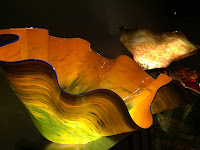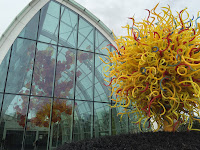For a short history of glass art, your kids will find it interesting that glassmakers were once forbidden to leave Venice or teach their skills to foreigners. It's interesting how change creates new connections. The secrecy of the craft was maintained until 1962. Harvey Littleton started teaching glass blowing at the University of Wisconsin in 1962 and Dale Chihuly was enrolled in the first glass program. Chihuly was the first American invited to work at Veneni glass factory in Venice. In 1998, Chihuly created Chihuly Over Venice exhibit and installed them over canals and piazzas of Venice. His art connected him back to Venice.
The year 1962 wasn't only the first glass program in the United States, it was also the year Seattle hosted the World's Fair. Ever since then, the Space Needles has remained an icon.
Born in Washington, Chihuly was invited by the Wright family who owns the Space Needle to present his work. In 2011, the Chihuly Garden and Glass construction began. Chihuly repurposed an existing building on 1.5 acres near the Space Needle for a long-term exhibit. His art connected back to his community.
Born in Washington, Chihuly was invited by the Wright family who owns the Space Needle to present his work. In 2011, the Chihuly Garden and Glass construction began. Chihuly repurposed an existing building on 1.5 acres near the Space Needle for a long-term exhibit. His art connected back to his community.
You and your family will really enjoy the visually spectacular space and glass of the Chihuly Garden and Glass exhibit in the Seattle Center. While it's not close to free admission ($32 per adult, $49 package with nearby Space Needle), it's such a unique experience to see Chihuly art both inside and outside. I've seen his art in botanical garden installation, but not the close up exhibit which includes his Macchia series. Macchias was one of his collections in the 1980s, along with Seafoams, Venetians, and Persians. Macchia comes from the Latin word macula meaning a stain or spot. Chihuly began Macchia with an inspiration to use all 300 colors in his hotshop, fusing colored glass chips on the the exterior layer to create a spotted effect. If you want to buy a Macchia art piece, it will cost you 6 to 9 thousand dollars. Now the $32 entrance doesn't sound too bad.
After buying your ticket, you will enter the indoor exhibits which includes eight galleries. In a dark room, the Chihuly glass in vibrant color lights up the room. Other people walked into the room and we all stared in silence. Ikebana and Float Boats pictured here is one of the two wooden boats used as a base for the exhibit. Chihuly presented his first chandelier piece at t 1992 exhibition at the Seattle Art Museum. In Seattle, you can see impressive chandeliers hanging from the ceiling at this location. A green one, a blue and white one, a red one, and the green one photographed here.
You'll proceed to the glass house. There is something about art combined with space and light that has a wow factor and luxurious feel. The 40-foot tall glass and steel structure covers 4,500 feet. Light fills the room and you'll admire the 100-foot long orange and yellow glass sculpture suspended above you.
You'll continue to see different art pieces in the gardens outside such as icicle towers and reeds on logs. I was fortunate to time my visit right to a live glass demonstration. While in Seattle, I also recommend you visit Pike Place Market and it's free entry! Read my blog story about my experience.








No comments:
Post a Comment